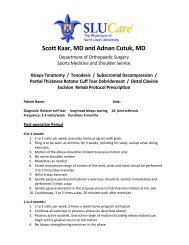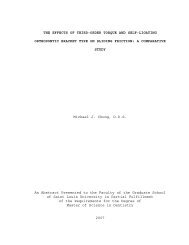Program Manual - Saint Louis University
Program Manual - Saint Louis University
Program Manual - Saint Louis University
Create successful ePaper yourself
Turn your PDF publications into a flip-book with our unique Google optimized e-Paper software.
7. Bulk disposal items, such as cements, should only be dispensed in anticipated use<br />
amounts. Unused amounts must be discarded and not returned to their bulk<br />
containers. Single use packaging should be used whenever possible.<br />
8. Any items not suitable for heat sterilization must be clinically disinfected in a<br />
manner designed to render it free of infection.<br />
a. Scrub with detergent and brush over sink to remove “Bioburden”. Rinse.<br />
b. Spray with a disinfectant and leave wet for 10 minutes.<br />
c. Rinse under water before use.<br />
9. Sterilized and disinfected items should be stored in a manner designed to maintain<br />
the initial degree of asepsis’. Individually closed packaging is desired. Bulk closed<br />
packaging is a secondary choice. Loose non-packaged items are not acceptable and<br />
must be considered contaminated and require re-sterilization before patient use.<br />
Clinic Protocol<br />
DO NOT WEAR GLOVES in hall, at dispensing window, in waiting room, meeting<br />
patients, on phone, making appointments.<br />
Washing Gloves<br />
Do not Wash Gloves for Infection Control Purposes or for reuse.<br />
NEW GLOVES MUST BE USED FOR EACH PATIENT.<br />
Set-up for the day<br />
1. Wash hands and put on gloves.<br />
2. Flush all waterlines for at least 3 minutes to reduce any microorganisms that may<br />
remain overnight.<br />
Preparing for the patient<br />
1. Flush all waterlines for 30 seconds between patients.<br />
2. If the operatory has not been prepared, clean and disinfect the unit with an EPA<br />
registered tuberculocidal disinfectant capable of killing both lipophilic and hydrophilic<br />
microorganisms at used dilution. Cleaning may also be accomplished by using soap<br />
and water prior to surface disinfection.<br />
3. The environment of the clinic must always be clean and neat. Cover surfaces that<br />
will be contaminated, but not cleaned and disinfected between patients, with approved<br />
barriers.<br />
Any surfaces (horizontal and vertical) within 3 feet of the patient’s mouth must be<br />
considered contaminated after providing treatment that produces spatter. Therefore<br />
cabinet doors and drawers must be closed during treatment. However, only surfaces<br />
that are touched must be cleaned and disinfected or have disposable covers changed<br />
between patients.<br />
10

















